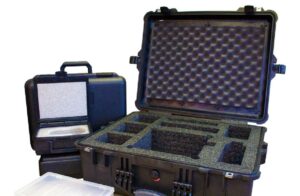
Explore the benefits of different foam materials for custom transit cases.
When safeguarding your valuable equipment and delicate items during transit, choosing suitable foam materials is essential. Custom transit cases are a popular choice for professionals across various industries, from military and aerospace to medical and audiovisual, and often, the key to their success is the foam interior. At Packaging Strategies, Inc., we frequently utilize custom foam materials to provide comprehensive protection within transit cases. If you want to learn more about the different foam materials for custom transit cases and how each is used, keep reading to determine which best suits your needs.
Polyethylene Foam
Polyethylene foam is a versatile and cost-effective choice for custom transit cases. This closed-cell foam offers excellent shock absorption, making it ideal for protecting fragile items. It comes in various densities, allowing you to tailor the level of protection to your specific requirements. Additionally, polyethylene foam is resistant to moisture and chemicals, making it suitable for a wide range of applications. This foam is best used for:
- Protecting fragile or delicate items such as electronics, glass, and instruments.
- When cost-effectiveness is a priority.
- In applications where resistance to moisture and chemicals is essential.
Polyurethane Foam
Polyurethane foam is another popular option for custom transit cases. This foam material is known for its high energy absorption capabilities, effectively dampening shocks and vibrations. It comes in different densities and can be easily customized to fit the contours of your equipment. Polyurethane foam is also resistant to wear and tear, ensuring long-lasting protection. This foam is ideal for:
- For shock and vibration-sensitive equipment like cameras, scientific instruments, and medical devices.
- When a snug, tailored fit is required.
- In applications where durability is crucial.
Convoluted Foam
Convoluted foam, often called “egg crate foam” due to its unique texture, is an excellent choice for cushioning and protecting items in transit cases. It is made from either polyethylene or polyurethane foam and provides a snug fit for your equipment. The convoluted design helps distribute weight evenly and minimizes movement within the case. Use convoluted foam for:
- Safeguarding items with irregular shapes.
- Preventing equipment from shifting during transport.
- Enhancing the overall cushioning effect within the case.
Plank Foam
Plank foam is a solid, rectangular foam material that offers high durability and protection. It can be easily cut and shaped to fit the specific dimensions of your transit case. Plank foam is a versatile option and can be combined with other foam materials to create a tailored solution. Use this foam when:
- Customizing foam interiors for unique equipment.
- Combining with other foam types to achieve the desired level of protection.
- In cases where a high degree of customization is required.
How Do You Know Which Foam Materials You Need?
Choosing the right foam materials for your custom transit case is a crucial decision. To make an informed choice, consider the following factors:
- Equipment and Contents: Assess the nature of the items you must protect. Are they fragile, sensitive to shocks, or irregularly shaped?
- Transit Conditions: Consider the environment in which your transit case will be used. Will it be exposed to extreme temperatures, moisture, or chemicals?
- Customization: Determine the customization required for your transit case’s interior. Some foam materials are more versatile in this regard.
- Budget: Consider your budget constraints and select foam materials that strike a balance between cost and protection.
The experienced transit case designers at Packaging Strategies, Inc. will work with you to determine the best foam materials for your transit cases and install them so they consistently protect your valuable cargo.
DEPEND ON PACKAGING STRATEGIES FOR YOUR CUSTOM PACKAGING NEEDS
Packaging Strategies has assembled a team with over 100 years of experience in design, engineering, development, manufacturing, and sales. We created the Packaging Strategies Design and Technology Center to create and manufacture complete systems integration packages and container solutions of all sizes and materials for our clientele. Many of these clients are federal agencies or in the private sector. No matter what you need to carry, Packaging Strategies is sure to have the right case for the job. You can view our website here, and follow us on Facebook, Twitter, Flickr, and LinkedIn.
This entry was posted on Monday, October 30th, 2023 at 2:42 pm. You can follow any responses to this entry through the RSS 2.0 feed. You can leave a response, or trackback from your own site.